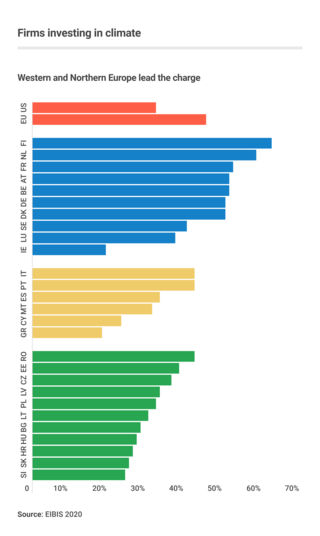
Business action on climate change includes a range of activities relating to climate change, and to influencing political decisions on climate change-related regulation, such as the Kyoto Protocol. Major multinationals have played and to some extent continue to play a significant role in the politics of climate change, especially in the United States, through lobbying of government and funding of climate change deniers. Business also plays a key role in the mitigation of climate change, through decisions to invest in researching and implementing new energy technologies and energy efficiency measures.

The energy policy of the United States is determined by federal, state, and local entities. It addresses issues of energy production, distribution, consumption, and modes of use, such as building codes, mileage standards, and commuting policies. Energy policy may be addressed via legislation, regulation, court decisions, public participation, and other techniques.

The Energy Independence and Security Act of 2007, originally named the Clean Energy Act of 2007, is an Act of Congress concerning the energy policy of the United States. As part of the Democratic Party's 100-Hour Plan during the 110th Congress, it was introduced in the United States House of Representatives by Representative Nick Rahall of West Virginia, along with 198 cosponsors. Even though Rahall was 1 of only 4 Democrats to oppose the final bill, it passed in the House without amendment in January 2007. When the Act was introduced in the Senate in June 2007, it was combined with Senate Bill S. 1419: Renewable Fuels, Consumer Protection, and Energy Efficiency Act of 2007. This amended version passed the Senate on June 21, 2007. After further amendments and negotiation between the House and Senate, a revised bill passed both houses on December 18, 2007 and President Bush, a Republican, signed it into law on December 19, 2007, in response to his "Twenty in Ten" challenge to reduce gasoline consumption by 20% in 10 years.

The energy policy of Australia is subject to the regulatory and fiscal influence of all three levels of government in Australia, although only the State and Federal levels determine policy for primary industries such as coal. Federal policies for energy in Australia continue to support the coal mining and natural gas industries through subsidies for fossil fuel use and production. Australia is the 10th most coal-dependent country in the world. Coal and natural gas, along with oil-based products, are currently the primary sources of Australian energy usage and the coal industry produces over 30% of Australia's total greenhouse gas emissions. In 2018 Australia was the 8th highest emitter of greenhouse gases per capita in the world.

The California Energy Commission, formally the Energy Resources Conservation and Development Commission, is the primary energy policy and planning agency for California.

The United States produced 5.2 billion metric tons of carbon dioxide equivalent greenhouse gas (GHG) emissions in 2020, the second largest in the world after greenhouse gas emissions by China and among the countries with the highest greenhouse gas emissions per person. In 2019 China is estimated to have emitted 27% of world GHG, followed by the United States with 11%, then India with 6.6%. In total the United States has emitted a quarter of world GHG, more than any other country. Annual emissions are over 15 tons per person and, amongst the top eight emitters, is the highest country by greenhouse gas emissions per person. However, the IEA estimates that the richest decile in the US emits over 55 tonnes of CO2 per capita each year. Because coal-fired power stations are gradually shutting down, in the 2010s emissions from electricity generation fell to second place behind transportation which is now the largest single source. In 2020, 27% of the GHG emissions of the United States were from transportation, 25% from electricity, 24% from industry, 13% from commercial and residential buildings and 11% from agriculture. In 2021, the electric power sector was the second largest source of U.S. greenhouse gas emissions, accounting for 25% of the U.S. total. These greenhouse gas emissions are contributing to climate change in the United States, as well as worldwide.

The Clean Cities Coalition Network is a coordinated group of nearly 100 coalitions in the United States working in communities across the country to advance affordable, domestic transportation fuels, energy efficient mobility systems, and other fuel-saving technologies and practices. The U.S. Department of Energy’s Office of Energy Efficiency and Renewable Energy’s Vehicle Technologies Office facilitates national coordination of the coalitions through its Technology Integration Program. The Network consists of 79 coalitions that work with more than 15,000 local stakeholders that have helped shift nearly 10 billion gasoline gallon equivalents of conventional fuel to alternative fuels or energy efficiency improvements, put more than 1.1 million alternative fuel vehicles on the road, and contributed to the expansion of alternative fueling station infrastructure since 1993. As of early 2020, there were more than 29,000 fueling stations nationwide that provide at least one of the following alternative fuels: ethanol (E85), biodiesel, compressed natural gas, electric, hydrogen, liquefied natural gas, renewable natural gas, or propane.
American Clean Skies Foundation (ACSF) is a 501(c)(3) not-for profit organization based in Washington, D.C., United States. It advocates for a cleaner, low-carbon environment through the expanded use of alternative energy sources and energy efficiency. ACSF stopped operations in 2019 pending further funding.
New Energy for America was a plan led by Barack Obama and Joe Biden beginning in 2008 to invest in renewable energy sources, reduce reliance on foreign oil, address global warming issues, and create jobs for Americans. The main objective of the New Energy for America plan was to implement clean energy sources in the United States to switch from nonrenewable resources to renewable resources. The plan led by the Obama Administration aimed to implement short-term solutions to provide immediate relief from pain at the pump, and mid- to- long-term solutions to provide a New Energy for America plan. The goals of the clean energy plan hoped to: invest in renewable technologies that will boost domestic manufacturing and increase homegrown energy, invest in training for workers of clean technologies, strengthen the middle class, and help the economy.
New York has 2,192 MW of installed wind power capacity as of 2022. Most of New York's wind power is located in upstate New York as onshore wind farms. New York has set a goal of developing 9,000 MW of offshore installed wind power capacity by 2035 that will power an estimated 6 million homes. As of October 2022, New York has five offshore wind farms in development with approximately 4,300 MW installed capacity.

New York energy law is the statutory, regulatory, and common law of the state of New York concerning the policy, conservation, taxation, and utilities involved in energy. Secondary sources have also influenced energy law in New York.
The climate change policy of the United States has major impacts on global climate change and global climate change mitigation. This is because the United States is the second largest emitter of greenhouse gasses in the world after China, and is among the countries with the highest greenhouse gas emissions per person in the world. In total, the United States has emitted over a trillion metric tons of greenhouse gasses, more than any country in the world.
United States energy law is a function of the federal government, states, and local governments. At the federal level, it is regulated extensively through the United States Department of Energy. Every state, the federal government, and the District of Columbia collect some motor vehicle excise taxes. Specifically, these are excise taxes on gasoline, diesel fuel, and gasohol. While many western states rely a great deal on severance taxes on oil, gas, and mineral production for revenue, most states get a relatively small amount of their revenue from such sources.
Conservation Services Group (CSG) is a nonprofit energy efficiency and renewable energy company that has provided program design and management services to energy efficiency program sponsors and energy professionals in the United States since 1984. CSG was bought by CLEAResult in July 2015.
Sustainable Energy Utility (SEU) is a community-based model of development founded on energy conservation and the use of renewables, seeking to permanently decrease the use of source materials, water, and energy. The model prescribes the creation of independent and financially self-sufficient non-profit entities for energy sustainability through conservation, efficiency, and end-user based decentralized renewable energy in an effort to address concerns about climate change, rising energy prices, inequity of energy availability, and a lack of community governance of energy development. The SEU model was developed by Dr. J. Byrne at the Center for Energy and Environmental Policy, University of Delaware. The Foundation for Renewable Energy and Environment (FREE) is implementing versions of the model.

Richard L. Kauffman is the first New York State "energy czar," officially referred to as the Chairman of Energy and Finance for New York in the administration of New York Governor Andrew Cuomo. In this role, Kauffman is New York State's most senior energy official, responsible for all aspects of energy policy and agency operation, and leads the state's "Reforming the Energy Vision" initiative.
A green bank is a financial institution, typically public or quasi-public, that employs innovative financing techniques and market development tools in collaboration with the private sector to expedite the deployment of clean energy technologies. Green banks use public funds to leverage private investment in clean energy technologies that, despite their commercial viability, have struggled to establish a widespread presence in consumer markets. Green banks aim to reduce energy costs for ratepayers, stimulate private sector investment and economic activity, and expedite the transition to a low-carbon economy.

As the most populous state in the United States, California's climate policies influence both global climate change and federal climate policy. In line with the views of climate scientists, the state of California has progressively passed emission-reduction legislation.












